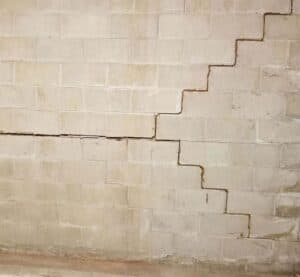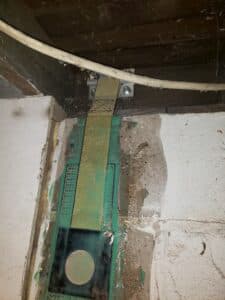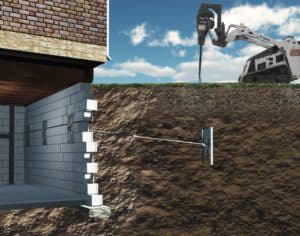Bowing Walls in a Crawl Space Are Harder to Repair

Originally posted 9/15/21; updated 12/15/22
If you’ve searched for “bowing walls” or “cracked walls” in our Learning Center, you know we’ve explored this topic pretty thoroughly. But all of these articles reference cracks and bowing in basements.
While it’s not as common for a crawl space wall to crack and bow inward, it does happen. But it’s harder to make repairs in a more limited area. Started in 1996, Acculevel is a family-owned and operated company that focuses on waterproofing and repairing foundations. We understand that strengthening and repairing your foundation is crucial to maintaining a healthy home.
We’re going to explain what causes a wall to bow, why it’s a threat to your home’s stability, and what the repair options are in a crawl space.
Why is Your Crawl Space Wall Bowing Inward?
The primary cause of bowing walls in any foundation (basement or crawl space) is hydrostatic pressure. This forms when the rain exceeds what your soil can absorb. The excess water presses against your foundation, creating pressure that can force the wall inward.
The first signs of trouble are usually cracks in the foundation; they may be long horizontal cracks if you have a poured concrete foundation. The cracks may be more of a zig-zag if your foundation is made of concrete/cinder block.
Below, you can see an example of both kinds of cracks. (Yes, it’s from a basement, but it includes both crack types.) Water may also seep through these cracks, or through the concrete directly. Concrete is a porous material, so water can soak through it, given enough time.

This photo was taken by an Acculevel project advisor during a free home consultation.
The biggest problem with bowing walls in a crawl space for homeowners is a lack of visibility. Most people don’t go into their crawl space, so this problem can go undetected for months or even years.
Why is a Bowing Wall Such a Big Deal?
Once a wall begins to bow, it’s no longer fully supporting your home. Foundation walls are designed to resist vertical pressure: this is the weight and force of the house built on top of it.
Walls are not built to withstand horizontal pressure coming from the side.
So when hydrostatic pressure pushes against the foundation and creates a tiny break in the wall? Your wall starts to shift as it bows inward. Now that wall isn’t properly holding up its share of the house.
Your foundation isn’t flexible. When the water in the soil dries up and relieves the pressure, the wall won’t snap back into place. It will stay bowed slightly, and this compromises the stability of your home. Because when the next major rainstorm comes through, there’s already a weak spot. Hydrostatic pressure reasserts itself, and moves the wall a bit more. Repeat this often enough and over time, the wall will cave in.
How Can You Repair A Bowing Crawl Space Wall?
This is where we encounter the contractor’s biggest problem with repairing your crawl space: accessibility. We need the crawl space to be at least 18 inches tall. Anything less, and we don’t have enough room for the crew members or the equipment. And even if your crawl space is 36” tall, we may still have problems.
Carbon Fiber Straps: Pros and Cons
Carbon fiber straps are normally our “go-to” option when a wall is bowing. The ones we install are the strongest available on the market; they’re made of kevlar-grade carbon fibers woven together. They are adhered to the wall with an epoxy; once cured, the epoxy works like thousands of tiny rivets, locking the strap onto the wall. Carbon fiber straps are also the least expensive repair method, costing about $650-725 per strap.
Unfortunately, carbon fiber straps can only be used if your wall is bowing 2” or less. If the wall is bowing more significantly, you’re going to wall anchors. Another problem with carbon fiber straps is moisture; if your crawl space is wet, the epoxy won’t cure.

This photo was taken by an Acculevel crew member after installation. You can see how the strap is secured to the wall and bracketed to the sill plate at the top.
Wall Anchors: Pros and Cons
If your wall is bowing more than 2 inches, or if your crawl space is too damp, you’ll need wall anchors installed.

This is an illustration of wall anchor installation.
The “anchor” is the steel plate buried in the yard. A similar plate is attached to the crawl space wall, and then a steel post is run through the wall into the anchor. As the post is tightened, it exerts pressure on the wall, pulling it back towards its original position.
Wall anchors also have restrictions that you need to evaluate. The wall must be at least 3 blocks high below ground. It can be taller, but it cannot be shorter. Anchors cost more to use; they’re $830-1,000 each. And the anchor portion requires excavation, and it needs to be placed 10 feet away from the bowing wall. If this is going to cross your property line, or interfere with something significant like your garage or septic tank, this could be a major issue.
Foundation repairs are not an area for DIY experimentation. This is especially true if you have a wall that is bowing or leaning. There are too many opportunities for something to go wrong; you could hurt yourself or further damage your home if the right precautions are not taken. Your house is your single greatest investment; don’t let anyone but an expert make any significant repairs to it.
Are You Worried about Your Crawl Space Foundation?
Complete our online contact form or call Acculevel at 866-669-3349.. We have helped more than 30,000 homeowners throughout Indiana and the surrounding areas; we install the best products available and provide the best warranties in our industry.
When you make an appointment with us, our project advisor will arrive on time. They will sit down and discuss your concerns, your plans for your home, and the symptoms that you have experienced. Then, they will thoroughly evaluate your home, diagnosing the problems and determining the best solution(s) we have to offer.
Our goal is to provide you with a whole-home solution, a plan that addresses your complaints and will resolve them as efficiently as possible. We will treat your home as if it were our own, offering 5 star service every step of the way.
f you do not live in our service area, please make sure you are working with a reputable and properly insured contractor. Verify that they are accredited by the Better Business Bureau, and check their reviews from multiple sources. We have developed a guide of Questions You Should Ask a Contractor; please use this to protect yourself from potential scam artists, and be certain you are working with a business that is the right fit for you.